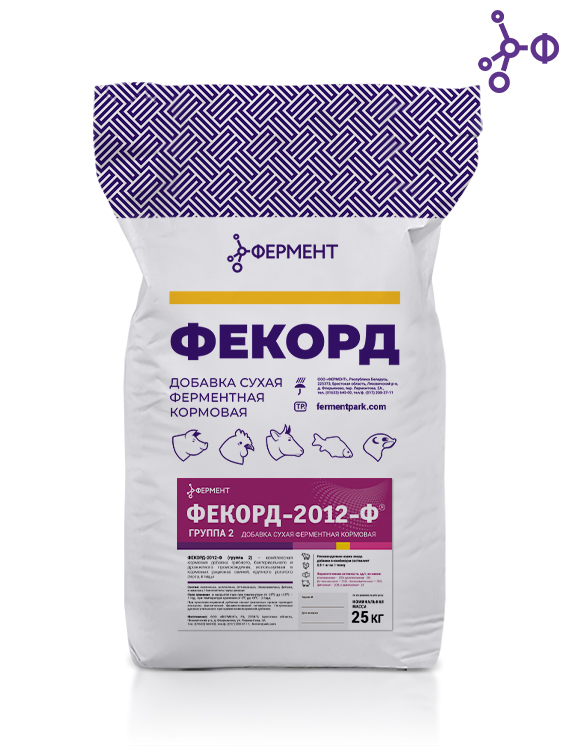- Ferment ООО
Dry enzyme feed additive:
-
"Fekord-2012-F (group 1)";
-
"Fekord-2012-F (group 2)".
Composition
Enzymes: cellulase, xylanase, glucoamylase, α-amylase and β-glucanase (producer strains - Trichoderma reese, Aspergillus niger, Aspergillus oryzae, Bacillus amydoliguefaciens, Bacillus subtilis, Pichia Pastoris), filler (wheat flour, rye flour, wheat bran, rye bran, silicon oxide, etc.).
Purpose
It is used in the feed rations of farm animals and poultry to improve the nutrient value and accessibility of phosphorus from plant ingredients by decomposition of phytic acid and destruction of carbohydrates which are difficult to hydrolyze.
Biological properties
-
destruction of anti-nutritional non-starch polysaccharides;
-
destruction of grain endosperm cell walls and increase of cellular starch and protein availability for endogenous enzymes in poultry and animals;
-
increase of digestibility of raw protein, carbohydrates and lipids of the feed;
-
decrease of feed viscosity, improvement of nutrients digestibility and their absorption in the small intestine;
-
decrease of specific feed consumption per unit of the manufactured products;
-
increase of livestock and poultry productivity.
Presentation
Cream white to light brown homogeneous powder.
How to use
for agricultural birds, pigs and bovine cattle of any age and sex groups, feed additives are recommended for inclusion in diets containing up to: 65% of wheat, 30% of rye, 70% of barley, 50% of oatmeal, 20% of wheat middling, 20% of sunflower oil meal, 60% of triticale, 75% of corn and other forage products with the increased content of non-starch polysaccharides (NPS) and phytine compounds.
Recommended rate of enzyme feed additives adding to the compound feed for pigs, cattle and poultry:
-
"Fekord-2012-F" (group 1) - up to 100 g per 1 ton of feed;
-
"Fekord-2012-F" (group 2) - from 500 to 1000 g per 1 ton of feed.
The additives are introduced at the plants producing premixtures, AVMA and compound feed or at the feed shops, by using current mixing technologies.
Stability
Feed additives remain effective at pH value from 2.0 to 9.0. They shall withstand temperature up to 95°С during granulation.
Safety interval
Agricultural products obtained after the application of feed additives, can be used for feeding purposes without restrictions.
Advantages of using
-
hydrolytic cleavage of arabinoxylans and β-glucans, cellulose and other non-amyloid polysaccharides contained in feed;
-
more complete digestion of nutritional substances;
-
reduction of specific feed consumption per unit of the products produced;
-
significant increase in the digestion of calcium, protein, and energy;
-
increase in the availability of proteins, amyno acids, and carbohydrates;
-
increase in the survival of livestock;
-
digestive enzyme deficit compensation in early stages of young livestock animal growth and during the stress when the production of native enzymes is limited;
-
viscosity reduction of the contents in the upper intestine;
-
reduction of water consumption;
-
phosphorus release from the phytate cereal complex by means of the phytase action;
-
reduced necessity of the application of phosphorus additives by 5-8 times and the application of meals and cakes by 1-1.5 % without deteriorating the quality of mixed feed;
-
increased gain of weight of animals and poultry and increased poultry egg-laying capacity.
Efficiency
The application of the feed additive in mixed feed for poultry contributes to the increase in the digestion of starch, proteins, lysine, methionine, and lipids by 6.3-10.2 %; the increase in the average daily gain in weight by 9.3-13.1 %, in egg-laying capacity by 2.3-4.5 %; the reduction of the feed consumption per unit of production by 5.7-14.3 %; the increase in the phosphorus digestion by 80-90 %, whereby the environmental situation is improved by means of more complete digestion of nitrogen and phosphorus by the poultry body, which consequently reduces discharge of these substances into the atmosphere by 20-40 %.
With the use of FEKORD-2012-F in pig feeding, the average daily weight gain increases by 12.3%; the digestibility of crude protein increases by 7.2-9.8%, essential amino acids - by 5.4%, starch - by 5.4-7.5%, calcium - by 8.7-14.3%, phosphorus - by 17.6- 28.3%, and the amount of phosphorus in feces decreases, which in turn contributes to an improvement in the environmental situation. The application of FEKORD-2012-F reduces the feed consumption for production by 7.2-15.2 %, increases the swine productivity by 3-8 %, and reduces the incidence of intestinal diseases.
The application of FEKORD-2012-F in young cattle stock rations increases the digestion of dry substances by 4.9-10.6 %, organic substances by 2.7-4.0 %, crude protein by 4.5-6.6 %, crude fat by 3.9-8.5 %, crude fiber by 4.4-8.5 %; increases the lactation performance by 7.3-10.3 %; reduces the milk production costs by 7.6-13.1 %; reduces the feed consumption per unit of production by 8.6-11.2 %; increases the milk production profitability by 8.3-16.8 %, and allows to gain additional profit from sales of products during the days in milk.



